Based on “A New Geometry of Forces” ©1989, ©2001, ©2012
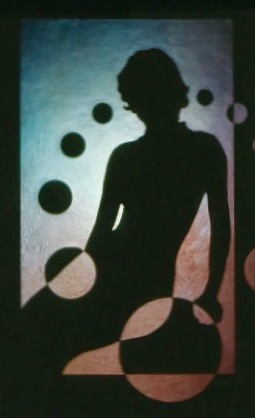
In light of cosmological data relating to dark energy, dark matter and the accelerating universe; can any more relevant information be gleaned from the orbital astrometry of the Sun, Earth, Moon? That is a significant question because the modifications in reasoning required by expanding matrix theory would invoke a change in syntax as to what is actually taking place in any orbital configuration.
The physics of traction can be a confusing phenomenon to contemplate. This is because, depending on one’s point of view, it can engender opposite meanings. In engineering and medicine, it is almost exclusively used to describe pulling, which can be confused with the concept of attraction. Its real meaning though relates to friction and friction is related to as a repulsing mechanism. The confusion arises because traction and friction can only exist when there are repulsive forces directed towards each other, whereas one tends to think that an attractive force is necessary to accomplish this. If we take as an example; a tractor skidding on an inclined surface of polished ice; in order to eliminate slippage and gain traction (without using chains, sand etc.), friction has to be increased. This can be done by increasing the pressure between the ice and the tires, either by reducing the surface contact of the tires or adding more weight to the tractor. Now it can be argued that adding more weight has increased the gravitational or attracting forces. But, consider for a moment; the same pressure could be achieved by controlled cinching of the tractor to the roadway (inclined plane). Thereby, the same friction could be attained (of course in order for the tractor to advance forward, an elaborate moving-cinch system would be needed). That of course is beside the point. The illustration demonstrates that what is increasing traction / friction in the latter instance is not a true attracting force at all, but the linkages and contacts via the physics of repulsive forces.
This is where the discussion gets interesting, because according to Einstein’s principle of equivalence, inertial forces are equivalent to gravitational forces. Gravitation makes objects fall with no forces acting on them (this has been proven to be true). Yet, the force pushing up under your feet or the tractor tires…when examined in light of the above is a repulsive force.
It is this fact that I’m asking readers to contemplate in examining the articles related to expanding matrix theory.
Gravity as a Tractional Force
This article studies the gravitational relationship between our earth, sun and moon. It demonstrates how a “tractional boundary” seems to appear at what can be perceived as a “crest-point” outwards in the field-space beyond our moon. This would appear to be causing traction in the sense of; grip, resistance or adhesion.
An Analysis of Gravity
In the classical interpretation of planetary orbits, there is a delicate balance of attracting centripetal (gravitational) forces and newton forces sometimes referred to as centrifugal forces (a misnomer). This implies that the earth’s orbit is the result of two opposing forces, which have arrived at equilibrium in order to produce the observed stable configuration. General relativity on the other hand explains gravitation as a curvature of spacetime, with objects and light following these curvatures.
The reader may have concluded by now that expanding matrix theory recognizes only one primary mechanism as the cause of orbital geometries and the apparent curvatures of spacetime. I have deferred to calling this a “primary mechanism” for a reason. It’s not that I don’t believe it should be called a “force” according to some criteria. It is because in expanding matrix theory, gravity is not really a true force but actually a “negative energy sink”, which appears like a force. This “negative energy ” concept already exists in quantum theory but for another reason, merging with the precepts of EMT at a deeper level. I therefore want to be very careful as to how I introduce new semantics.
I might add a caveat regarding the two classical gravitational theories, Newton’s and Einstein’s. They both work, but Einstein showed that Newton’s theory works for the wrong reasons. This shows how parallel and congruent physical truth can be, like layers in an onion, both can have the same latitude and longitude but the depth is different. I believe that expanding matrix theory probes another layer of the onion. Most modern discussions on astronomy and astrometry use Newtonian language because it is more intuitive to work with, even though it is accepted that a deeper level of truth exists through the lens of relativity theory. It behooves the reader then to keep these issues in mind when reviewing expanding matrix theory.
Orbital Astrometry of the Sun, Earth, Moon
In looking at the classical astrometry of orbits, planetary and lunar rotations appear to be the result of arbitrary momentum within the gravitational matrix. These are conjectured to be caused by meteor strikes (and regulated somewhat by ambient magnetic and electromagnetic forces). That is to say, there is no particular reason why the Earth spins a certain amount of days per year. Then there is the effect of synchronous rotation, the fact that the Moon rotates with the same face always towards the Earth. The tidal-lock theory has been a good working model since Newton but has a certain amount of circular logic associated with it, in that the bulge on the near side of the Moon causes the tidal-lock…whereas the tidal-lock, pulling on the earth for an epoch of time has caused the bulge. One also might actually expect that the Moon should have far more rotational activity then the Earth, as proportionally, it is hit by far more objects from space than the Earth and with one sixth the Earth’s mass and far more area per unit volume; should be affected by such to a far greater degree. This would imply that there seems to be a much more stable mechanism at work then has been traditionally accepted. Expanding matrix theory presupposes that the primary mover in the scenario is akin to a repulsing force that not only produces the observed stability but that accounts for the number of days in the year, as well as the precise Moon, Sun distances from the earth.
A Repulsing Force vs. an Attracting Force
A repulsing force is what you feel when you touch the surface of a solid object. Looking at planetary orbits within this context makes one anticipate a less arbitrary and a more traction-like response between those fields producing both orbital and rotational motion.
Astrometry With a New Point of View
The early progression of EMT precluded looking at astrophysics and astrometry from a slightly different point of view. One of the first things I noticed looking at the earth-moon-sun orbital configuration, was a similarity to inverted sun-wheel gears, with the circumference of the larger gear meeting near the Moon’s orbital circumference representing the circumference of the smaller gear (Fig.1a). When I began, I didn’t know if I should make the small wheel have its perimeter at the Moon’s center, its outer edge, or further out. My first impulse was to imagine a 3rd smaller wheel for the moon’s orbit field out beyond the moon. This might have made sense if the Moon had a rotation proportionally similar to the Earth’s but the fact that it’s same side is locked inwards so that it always faces the earth made me think that there may not be that 3rd wheel. Practically it didn’t matter, I could try the nearer orbits and if they didn’t match, I could nudge the calculations outwards until I got a match, then search for correlations to explain the figures.
Fig.1a (not to scale)
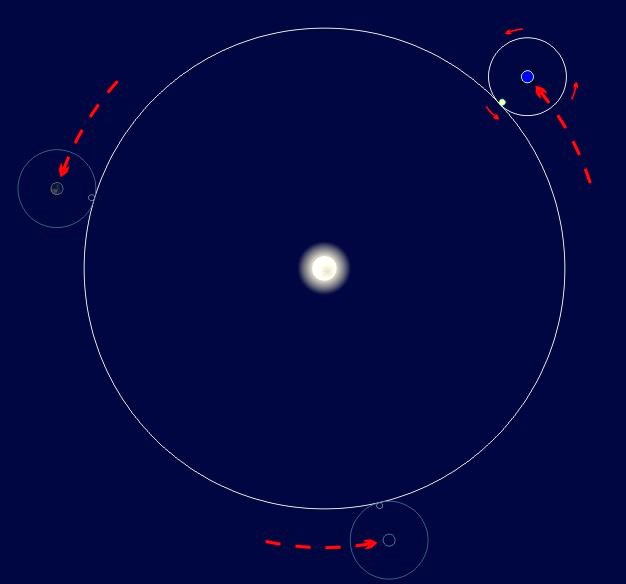
Fig.1a (not to scale)
Fig.1a was the way I originally imagined the configurations
Fig.1b is the way it actually turned out. There is not much difference but it creates an intriguing enigma I hope can be resolved.
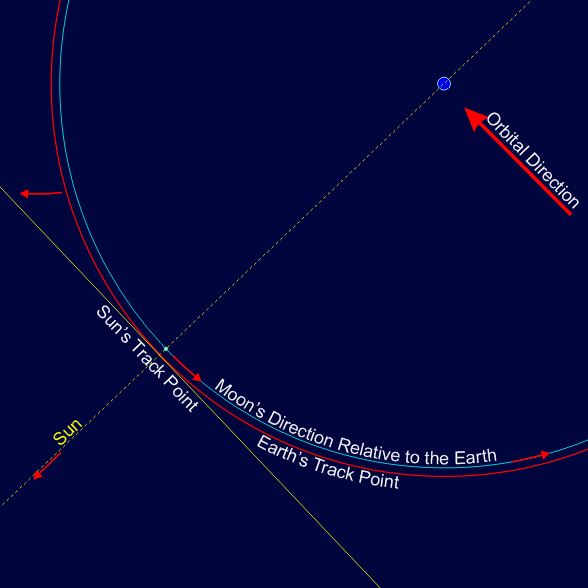
Fig.1b (to scale)
Fig.1b (to scale)
The Astrometry in 1989 and Now
Imagining the Earth as the hub of a giant invisible wheel with its rim out a short distance past where the Moon’s orbit is, then the daily rotation of the Earth could be projected out to this imaginary rim and the wheel could be perceived as rolling on an invisible track or wheel, which extends around the Sun at that same extremity. Because of the nature of energy within the expanding matrix, this type of geometry would be expected to act in a very precise way as if the rim had grip or traction with the track it ran on. If this were correct, a simple calculation should confirm its plausibility. The two wheels as described would give us a small number and a large number representing each circumference. Dividing the smaller number into the larger, should give us the days of the year.
The figures I used in 1989 were based on the then accepted distances that I found in an Encyclopedia. I was of the opinion at the time that the distances that I’d found were based on the “surface-to-surface” distances between the Earth, Sun and Moon, so I believe what I did was; that I added the radii of each of these to the total distances where applicable, to arrive at the approximate centers of each. I understand now that the stated distances are from barycenter to barycenter, meaning that I’d imposed extra distances into the sums. I also have a better understanding now of the term “barycenter”. As it turned out, the distance most closely approximating the results I’d expected, was obtained by using the aphelion, and a New Moon apogee;arriving at 365¾, so close to 365¼, that I was ecstatic. Using the aphelion/apogee was convenient but I would have felt more comfortable using the mean distances for all calculations. Today, with new universally accepted mean distances to the Sun and the use of barycenter measurements, one can expect more accuracy. There is always the hope too, that there may be researchers who are aware of geometries, anomalies or unusual orbital tracking that might help refine the results to a higher degree of accuracy. Irregardless, I am sure that many people who compare these figures will agree that there may be too close a correspondence to what is predicted be mere coincidence.
For anyone interested in these questions, the most recent calculations put the mean distance from the Earth to the Sun at: 149,597,870,700 meters.
Questions Regarding Variables Related to the Moon’s Astrometry:
-
Should the Earth-Moon system be treated as a single mass-system like two different sized balls on the ends of a stick, where the center of mass (barycenter) is at a point closer to the larger ball and an elliptical rim-field is scribed from that point?
-
Should the rim we are searching for be assumed to exist as a fixed Earth / Moon apogee and perigee with the Moon being seen as the hub of a smaller wheel that causes a “bump”like a bulge in a bicycle tire once every rotation? There may be esoteric writings on the subject that reveal anomalies in the Earth-Moon orbits that are lost with the publication of averages.
-
The primary question between the above issues are whether the Earth and Moon are to be treated within the context of the stated sun-wheel idea, as separate or combined elements.
-
Also, one would expect the rotation of the Earth-Moon-Sun gear-motion to cause an inverse symmetrical effect on the Sun’s movement, mediated by the distances, motions and masses. I don’t at this time feel I have enough information to make any comprehensive statement on such effects.
There may be enough obscure data available in modern astrophysics to answer most of the above questions. The following charts give an idea of how close the calculations are and hopefully someone will see valid correlations within the results.
When studying the Earth-Moon system (tides etc.), the term “friction” is used a great deal within the context of orbits (via Newtonian physics). In all the instances, friction is a valid effect but I would like the reader to compare the explanation with what Einstein said about gravity…that; “a falling object has no force acting on it”. When an object is falling, the forces drop away, so where does tidal-friction come from? I’m not saying they shouldn’t be there, I’m saying another effect is at work. I therefore invite the reader to examine these queries within the context of expanding matrix theory (EMT).
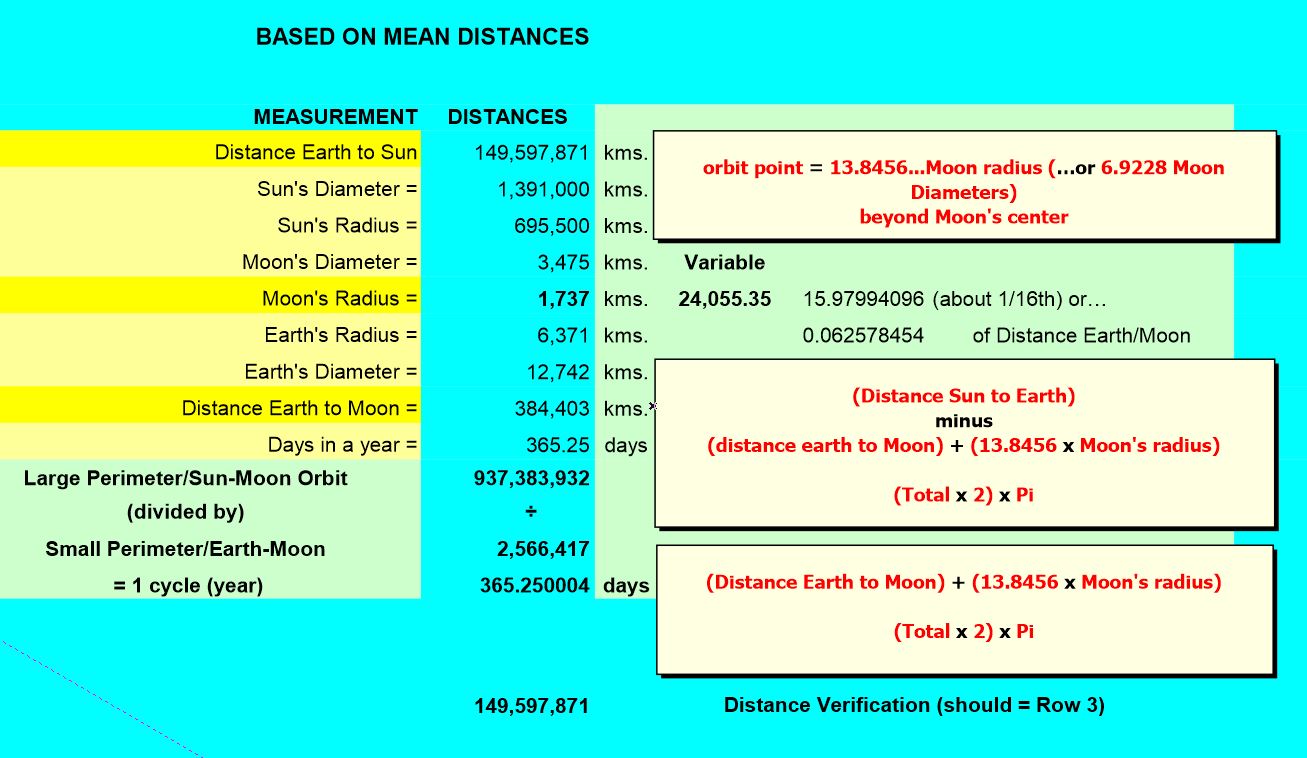
Fig.2
Fig.2
The above chart (Fig.2) was created to help determine a point between the Earth and Sun from where 2 elliptical perimeters could diverge; one around the sun and the other around the Earth-Moon configuration so that the smaller was exactly 1/365.25 the size of the larger. As it turns out, that point is 408,458 ks. from the surface of the Earth in line with the Sun. That distance is equivalent to about 6.43 Moon-diameters beyond the Moon (or 6.93 if measured from its center). This distance is about 1/16 of the distance from the center of the Earth to the center of the Moon. I expect that such a distance correlates somehow to the combined masses of the Earth and Moon but have not had the time or resources to evaluate it in light of the above bullet-list. Regardless I believe that these results do a lot to corroborate the “friction” or “traction”hypothesis spawned by expanding matrix theory. One positive point to be gleaned from these measurements is that only if the Moon orbited outside this track-point would we expect it to have a true rotational period. Being inside that point seems to account for its having one face locked towards the Earth.
Fig.3
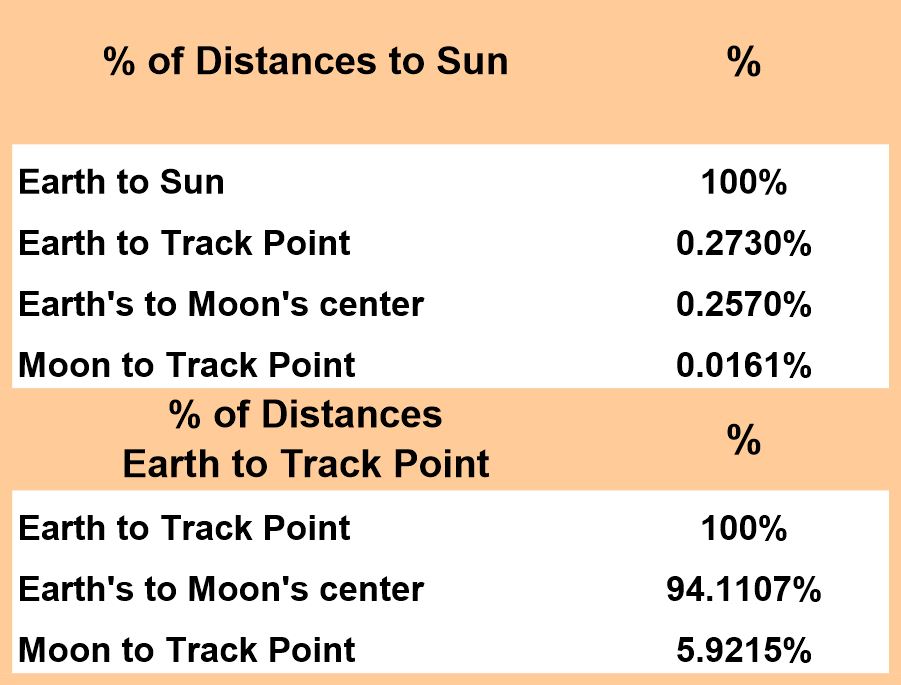
Fig.3
The above chart cites the percentage-values of the pertinent astrometry; Earth to Sun and Earth to the track-point. It’s my hope that solid correlations can be gleaned from these measurements and the distances in Fig.2.
Author’s Note
This section was included within the main body with those values arrived at to date rather than waiting for the time and resources needed to produce those more sophisticated values that I believe are possible. This is in the hope that among the many skilled professionals in the field, there may be someone with the esoteric data needed to fill in those gaps unavailable to me at this time.
